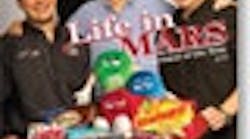Mars Inc. is the prototypical privately held company. With control largely in the hands of the Mars family, the $21 billion global company prefers to work quietly, grow its businesses organically and fight Hershey on the home front and Nestle on the global stage for leadership of the chocolate side of the candy business.
While the company was founded on candy - Frank and Ethel Mars started selling buttercream candies in Tacoma, Wash., in 1911 - the company has grown beyond candies and its U.S. foundation. Now, 60 percent of Mars sales come from outside of North and South America.
With the huge 2006 acquisition of Doane Pet Care, pet products now are one percentage point bigger in Mars North America sales than the Snackfoods division, which at the moment is synonymous with candy. There's also Uncle Ben's rice and a smattering of other food products.
Now, after the rebranding of the majority of the snackfood, petcare and food divisions back to the Mars name (after being called Masterfoods since 2002) and with its 100th birthday in sight, Mars opened its doors to Food Processing. With a stellar year behind it, Mars Snackfood division, specifically, is our Processor of the Year.
"All our associates have been working hard to become more nimble and accountable for their business unit's success," says Todd Lachman, president of Mars Snackfood U.S. "Being named Food Processing's Processor of the Year is an acknowledgement of the hard work, dedication and success of everyone associated with the Snackfood division."
Three years of transformation
Three years ago the company embarked on a journey of transformation when it acknowledged internally that its competitiveness had slipped. The goal was to restore what made this company great: empowered associates with clear roles and responsibilities, open communication and streamlined decision-making.
Since 2004, the company reorganized into segment-focused business units, generated efficiencies in overheads and supply costs and reinvested those savings into core brand support, new product launches, enhanced retail coverage and expanded production capacity.
One of the low points may have been the first half of 2006, when sales in the core Snackfood division dropped 2 percent. "The Snackfood division responded with decisive action, kicking into high gear and improving the speed and flexibility of decision-making," says Lachman, who came to Mars one year ago from Del Monte, where he was an executive vice president.
"The result was a phenomenal turnaround with growth in sales -- second half sales grew by 5.5 percent over 2005 -- earnings and market share," he continues. "And, more importantly, a stage was set for aggressively pursuing the No. 1 chocolate share position."
Here are some examples of what even a large organization can accomplish when it really wants to:
- Snickers Dark Bar, M&M'S Dark Chocolate Candies and Snickers Nut 'n' Butter, all planned for 2007 launches, were moved up to 2006 to fuel the year's second-half growth.
- Plant operations across the snack food division delivered almost $40 million in real savings.
- The commercial (purchasing) team saved $40 million in prime costs.
- And generally the division cut non-quality costs by $30 million.
All those savings were reinvested to drive additional growth.
There's still a ways to go to reach the ultimate goal. Hershey still holds the top market share in the chocolate category, but Mars has been adding points, bringing Mars to 29.0 percent market share (according to IRI data for the period ending Nov. 4). The Dove brand grew by 42.1 percent, 3 Musketeers by 18.2 percent, M&M'S by 8.3 percent and Twix by 11.8 percent. Snickers, the No. 1 candy single, grew by 8.7 percent.
"We have experienced great growth this year," says Lachman. "We have also seen an upswing in the growth of the sugar category in the last 12 weeks [ending Nov. 4]."
Dark chocolate and premium chocolate products currently are driving growth of the overall chocolate category. To the call for dark chocolate, Mars responds with several dark versions of familiar brands - such as M&M'S Dark Chocolate, Milky Way Midnight Dark, Snickers Dark, Dove Dark - as well as its 18-month-old CocoaVia brand, with the emphasis on the flavanols.
The Dove brand is an interesting story. Twenty-five years ago it was a popular line of ice cream bars that was available only in Chicago. Even then, what made the ice cream novelty stand out was the rich chocolate coating. Mars acquired Dove in 1986 from the founding family and continues to manufacture the ice cream bars at a suburban Chicago plant. More importantly, since the acquisition, Mars developed Dove as a premium chocolate brand.
"It was not that great a leap, but it was a great opportunity," Ralph Jerome, Mars Snackfood U.S. vice president of R&D, says in hindsight. "Before Dove, we didn't have a pure, solid chocolate bar. And we had a lot of premium chocolate expertise that was not being leveraged."
Dove also has two high-cacao products, at 63 and 71 percent cacao, as well as the Dove Origins line, naming Ecuador, Dominican Republic and Ghana as the sources of its cacao. The same personalized message technology that's being used in My M&M'S is being used to print custom messages on the inside of the foil of My Dove chocolates.
The Dove line will be further extended next year with Dove Beautiful. (click to enlarge)
The Dove line will be further extended next year with Dove Beautiful ("with skin-nourishing vitamins C and E, biotin and zinc") and Dove Vitalize ("with energy-releasing B vitamins, plus the natural goodness of cocoa flavanols").
"Dove Chocolate is the top selling brand of premium chocolate in the U.S.," says Lachman. "Within the top 10 chocolate brands, Dove is the fastest growing brand."
They know their chocolate
This is a company that has studied chocolate for nearly 100 years. That bean-to-bar knowledge led to the discovery in the late 1980s of flavanols, a class of plant compounds, in cocoa and their role in heart health, specifically cholesterol control. Mars claims to have done the earliest research and has more than 100 published papers and 80 U.S. patents relating to the subjects.
The research resulted in the mid-2006 introduction of CocoaVia, a groundbreaking product that put chocolate's health benefits front and center. While that product "continues to be an important part of our product portfolio," according to Lachman, the flavanol message is being moved more mainstream under the Dove brand, which has become Mars' premium chocolate brand.
"The health benefits of cocoa flavanols have been incorrectly simplified in consumer communications to equate flavanols with percent cacao in chocolate products," says Lachman. "It is the process by which the cocoa is processed that will help retain the flavanols. Mars has been the global leader in cocoa flavanol research for more than 15 years. We have employed that research to create the [patented] Mars Cocoapro process."
Furthermore, "In 2008, we will introduce a new CocoaVia beverage, which will deliver twice the amount of flavanols in a convenient format," says Lachman.
In addition to the R&D facilities in the U.S., Mars is the only manufacturer that has a research center in an "origin country." Research from the Mars Center for Cocoa Science in Bahia, Brazil, augments the main research and development facility in Hackettstown. Two pilot plants are in production facilities in Elizabethtown, Pa., and Cleveland, Tenn., the latter specializing in baked products (Twix cookie bars and Combos pretzel-like snacks). Elizabethtown, a two-hour drive west of Hackettstown, recently underwent a $70 million expansion and upgrade, especially to meet increasing demand for Dove chocolate.
"Product development starts in a very cross-functional way," says Jerome. "Within each business unit, people are charged with idea capture and generation. Plus, this is a big, global company, so good ideas get shared between sister units. A really good idea from Germany gets brought here. Our ideas are exported there."
Even "traditional" R&D, the chemistry of candy, is augmented by in-depth "consumer ethnographics" - why people like what they like and how they shop. "It's like being an anthropologist," says Jerome. "We even develop algorithms - psychographic and ethnographic - to understand the target audience."
More than chocolate
While Mars Snackfood has an undeniable focus on chocolate, it has several other successful products. In the candy realm, Mars makes Starburst and Skittles sugary candies and Munch, an all-peanut bar. The Twix brand has a cookie center surrounded by chocolate. Kudos granola bar was a first step into cereal/snack bars, which Mars has greatly expanded with energy bars under the Snickers Marathon brand. Combos, a filled pretzel nugget, is so far the only salty snack.
Earlier this year, the company launched the Generation Max line of snacks for teens. "We were the first company to develop a completely new product line designed to meet the stringent school nutrition guidelines in the U.S.," says Lachman. Generation Max clusters, snack bars, cookies, crackers and pretzel products all are less than 150 calories per serving and contain less than 35 percent of calories from fat, 10 percent of calories from saturated fat and 35 percent sugar by weight. All of the snacks are labeled zero grams trans fat, and are fortified with essential vitamins and minerals, such as vitamin D, B-vitamins and calcium.
More recent and future product introductions:
- 3 Musketeers Mint
- Dove Flavored Caramels
- M&M'S in Dark Chocolate Peanut, Razzberry and Wildly Cherry
- Skittles Carnival Gum and Chocolate Mix
- Snickers Dark and Nut 'n' Butter Crunch
- Twix Java
"We've done well. We have some of the best known and most loved brands in the world and the finest minds working on making them better or creating new brands," says Lachman.
"Snackfoods is a great business to be in - fun to make, fun to market, fun to eat. And if done right, the fun part of sensible eating," he continues. "Snacking is becoming an acceptable part of daily eating. So Mars Snackfoods U.S. is well positioned for future success."

